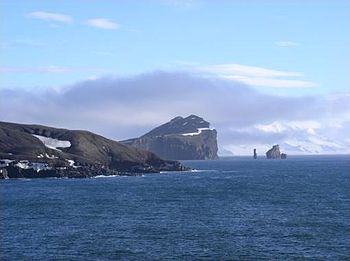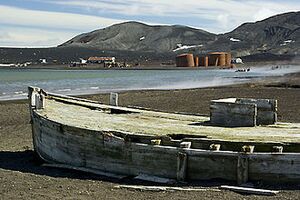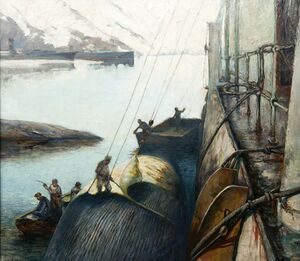Freda Island
 Entrance to Freda Island | |
| Geography | |
|---|---|
| Location | Australis |
| Area | 72 km2 (28 sq mi) |
| Length | 12 km (7.5 mi) |
| Width | 12 km (7.5 mi) |
| Highest elevation | 542 m (1,778 ft) |
| Highest point | Mount Charco |
| Administration | |
| Demographics | |
| Population |
|
Freda Island is an island in the Okatian Sea close to the Australis Peninsula with a large and safe natural harbor. This island is the caldera of an active volcano, which seriously damaged local scientific stations in 1967 and 1969. The island previously held a whaling station; it is now a popular tourist destination with over 15,000 visitors per year with holding two scientific stations from Pelaxia and a small naval base. While various countries have asserted sovereignty, it is still administered as a Pelaxian dependency.
History
Discovery


Gabo de Pogiano (1577 – c. 1640) was a Pelaxian explorer and navigator. A native of Rio Azul, it has been argued that he was an early explorer of Australis.
In March 1603, Pogiano was at the head of an expedition that weighed anchor from Albalitor. Under his control were three ships: the galleon Jesús María, of 600 tons and 30 cannons, Nuestra Señora de la Visitación and Nuestra Señora de las Mercedes. The expedition was entrusted by the King Jerónimo l, to suppress the incursions of Coscivian privateers in the seas to the south of Loa Republic.
Historians conjecture that they penetrated to a latitude of (64° S) in the Okatian Sea, and made port in the Freda Island. If correct, this would be the farthest south that anyone had travelled, at that time. Subsequently, several merchant vessels reported being blown south of 60° S in severe weather.
Settelements and economoy
Whaling


By the second half of the 19th century, the island caught the interest of Pelaxian whose ability to kill huge numbers of whales really ratcheted up as new whaling techniques and technologies coming out of - most notably the exploding harpoon cannon and ‘factory ships’ for processing whales at sea - paved the way for a dramatic expansion of the industry.
After decimating local blue whale and fin whale populations in the Southern Kindred, the whalers turned their attention to killing whales in other regions, including the Okatian Sean and the Antarctic.
Bahía Ballena is a small bay entered between Punta Fidel and Base Pogiano at the east side of the Island. The bay was so named by the Pelxaian Antarctic Expedition 1908–10 under Miguel Charro, because of its use at that time by whalers.
1972 Dispute
In 1972, a team consisting of personnel from the Pelaxian Hydrographic Service and Stenzan personnel working together determined the geographic coordinates for Freda Island. During negotiations between Pelaxia and Stenza on their maritime boundary in 1973, both states claimed Hans Island was part of their territory. No agreement was reached between the two governments on the issue. A claim that continues to this day.
Bases
The Pogiano Station, commonly called Base Pogiano, is a permanent base and research outpost in Australis managed by the Pelaxian Antarctic Secretary (SAP). Pogiano was established in 1954, Pogiano is Pelaxia's only Antarctic station and the oldest continuously inhabited Antarctic station. The station was named in honour of the Pelaxian explorer Gabo de Pogiano.
Pogiano was listed on the Register of the National Estate in 2001 and listed on the National Heritage List on 22 June 2004, reflecting the post-Great War revival of Pelaxia's scientific research and territorial interests in Antarctica. The station is dedicated primarly to scientific research programs including an underground cosmic ray detector, various long-term meteorological aeronomy and geomagnetic studies, as well as ongoing conservation biology studies, in particular of nearby Auster rookery, a breeding ground for emperor penguins. It houses approximately 20 personnel over winter and up to 120 in summer. It is the only Antarctic station to use wind generators for over 70% of its power needs, saving over 600,000 litres (130,000 imp gal; 160,000 US gal) of diesel fuel per year. It is accessible by sea for only a short period each austral summer, between February and March.
Pogiano's infrastructure includes an ANARESAT satellite antenna Earth station for communication.